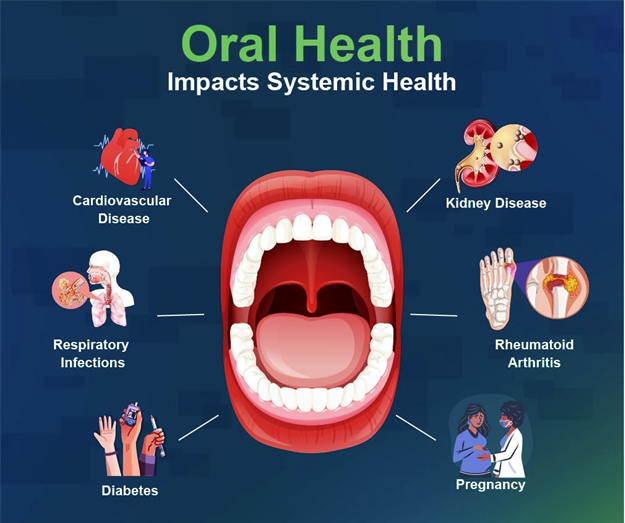What Dental Professionals Can Learn from Medical School Approaches to Diagnosis – Linking Oral Health to Systemic Conditions

Introduction
Dentists are often on the front line of patient care, examining areas of the body that can reveal far more than cavities or gum disease. Oral tissues, mucosa, and supporting structures frequently reflect the state of a patient’s overall health. In fact, systemic diseases such as diabetes, autoimmune conditions, and even early cancers may first present signs in the mouth. While dental professionals are experts in oral health, many diagnostic methods used in medical schools provide valuable insights that can enhance dental practice. By understanding how physicians are trained to detect disease, dentists can strengthen their role as comprehensive healthcare providers.
The Importance of Diagnostic Training in Medicine
Medical education emphasizes diagnostic reasoning as a cornerstone of patient care. From the first year, medical students are taught to approach patients holistically, gathering a full history, conducting thorough physical examinations, and considering a broad range of differential diagnoses before narrowing them down.
Institutions such as AUAMED (American University of Antigua College of Medicine) highlight this philosophy by integrating clinical skills early in the curriculum. Students are trained to connect symptoms across systems, ensuring they consider the patient as a whole rather than focusing solely on one area of concern.
This approach provides a useful model for dentists, who may benefit from broadening diagnostic thinking beyond the oral cavity.
Oral Health as a Window to Systemic Conditions
Systemic conditions often have oral manifestations. A few common examples include:
Diabetes: Gum disease severity is strongly linked to blood sugar control.
Anemia: Pale oral tissues, tongue soreness, or angular cheilitis can provide early clues.
Leukemia: Unexplained gingival bleeding or hyperplasia may raise suspicion.
HIV/AIDS: Candidiasis, hairy leukoplakia, or persistent ulcers are common oral indicators.
Cardiovascular disease: Periodontal inflammation is increasingly tied to heart health.
Dentists who adopt a more “medical school” approach to diagnosis can place these oral signs in a systemic context, recognizing when a referral to a physician is necessary.
Lessons Dental Professionals Can Learn from Medical Diagnostic Training
1. Comprehensive Patient Histories
Medical students are trained to collect detailed histories, including family medical conditions, medications, allergies, lifestyle habits, and psychosocial factors. Dentists may already ask about medications and allergies, but expanding into lifestyle and family history can reveal valuable risk factors — for example, autoimmune conditions or cardiovascular disease.
2. Differential Diagnosis
In medicine, students are taught to generate a “differential diagnosis” — a list of possible conditions that could explain a patient’s symptoms. For dentists, this skill is crucial when evaluating oral lesions. A white patch might be leukoplakia, lichen planus, or candidiasis — each requiring a different management plan. Borrowing the systematic elimination process from medicine strengthens accuracy.
3. Interdisciplinary Thinking
Medical schools emphasize that no organ system functions in isolation. Dentists can apply this principle by recognizing that oral health reflects systemic health. For instance, persistent dry mouth could be due to medications, autoimmune disorders, or endocrine imbalances. Thinking across specialties ensures better patient outcomes.
4. Early Clinical Exposure
Programs like AUAMED introduce medical students to clinical scenarios from the start, encouraging real-world application of knowledge. Dental professionals can mirror this approach by engaging in continuing education that bridges oral and systemic health, such as courses on cardiology, endocrinology, or immunology relevant to dentistry.
5. Empathy and Whole-Patient Care
Medical training emphasizes empathy and communication as essential diagnostic tools. A patient’s emotional or psychological state can affect both their medical and dental health. For example, stress exacerbates bruxism and gum inflammation just as it worsens eczema or hypertension.
Case Studies: Where Medical and Dental Diagnostics Meet
Case 1: Diabetes in the Dental Chair
A patient presents with chronic gum inflammation unresponsive to standard cleaning. By recalling how physicians consider systemic factors, the dentist investigates further and refers the patient for a blood glucose test. Diabetes is diagnosed early, thanks to the dental visit.
Case 2:Leukemia Clues
Another patient experiences recurrent oral bleeding despite good oral hygiene. A physician might suspect hematologic issues; applying this thinking, the dentist refers the patient for blood work, revealing leukemia at an early stage.
Case 3: Medication-Linked Xerostomia
Medical training teaches students to consider side effects of medications. Dentists can adopt this mindset when assessing dry mouth, connecting it to antihypertensive or antidepressant medications and advising patients accordingly.
Bridging the Gap: Collaboration Between Medicine and Dentistry
The overlap between oral and systemic health underscores the need for collaboration. Dentists should feel empowered to share observations with physicians, just as physicians may consult dental specialists when systemic disease affects the mouth.
Educational models like AUAMED’s emphasize interprofessional collaboration, preparing medical graduates to work seamlessly with dentists, pharmacists, and other healthcare providers. By adopting similar principles, dental professionals can elevate their role in patient care.
The Future of Integrated Care
As healthcare shifts toward holistic models, dentists who integrate medical-style diagnostic approaches will stand out as valuable members of the care team. Emerging research consistently highlights the oral–systemic link, from cardiovascular health to autoimmune disorders.
By learning from the way medical schools train their students — emphasizing history-taking, differential diagnosis, empathy, and collaboration — dental professionals can sharpen their diagnostic skills and contribute more meaningfully to patient health.
Conclusion
Dentists have always played a vital role in identifying oral diseases, but their role in recognizing systemic conditions is equally important. By borrowing approaches from medical school training — comprehensive histories, differential diagnosis, interdisciplinary thinking, and early clinical awareness — dental professionals can enhance both their diagnostic accuracy and their impact on patient well-being.
Institutions like the American University of Antigua College of Medicine (AUAMED) illustrate how medical education equips future physicians with these skills. For dentists, applying similar methods ensures they remain not only oral health specialists but also key partners in holistic healthcare.